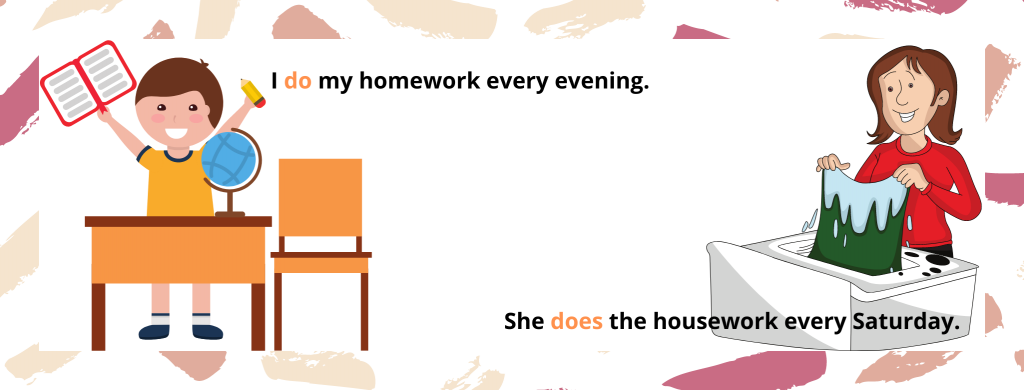โจทย์ present simple tense: นี่คือโพสต์ที่เกี่ยวข้องกับหัวข้อนี้
ใบความรู้
Present Simple Tense
หลักการใช้
Present Simple Tense ใช้กับเหตุการณ์ที่มีลักษณะดังต่อไปนี้
เหตุการณ์ที่เกิดขึ้นในปัจจุบัน
เหตุการณ์ที่เกิดขึ้นเป็นประจำ ทำบ่อย ๆ หรือทำจนเป็นนิสัย
สิ่งที่เป็นความจริงเสมอ หรือเป็นข้อเท็จจริงต่าง ๆ
รูปแบบประโยคของ Present Simple Tense
ประธาน + กริยาช่องที่ 1
รูปของกริยาใน tense นี้ เมื่อใช้กับประธานบุรุษต่าง ๆ และรูปประโยคชนิดต่าง ๆ มีดังนี้
บอกเล่า
ปฏิเสธ
คำถาม
คำถามปฏิเสธ
I work.You work.He
She works.
It
We work.
They work.
I do not work.You do not work.He
She does not work.
It
We do not work.
They do not work.
Do I work ?Do you work ?he
Does she work ?
It
Do we work ?
Do they work ?
Do I not work ?Do you not work ?he
Does she not work ?
It
Do we not work ?
Do they not work ?
รูปย่อของ do + not = don’t does + not = doesn’t
เช่น I don’t They don’t
You don’t We don’t
He / She doesn’t It doesn’t
หลักการเติม s หรือ es ที่ท้ายคำกริยา
1. คำกริยาโดยทั่วไปสามารถเติม s ได้เลย เช่น
walk = walks
sleep = sleeps
drink = drinks
eat = eats
2. ถ้าคำกริยาลงท้ายด้วย s, x, z, ch หรือ sh ให้เติม es เช่น
kiss = kisses
brush = brushes
watch = watches
fix = fixes
go = goes
buzz = buzzes
3. ถ้าคำกริยาลงท้ายด้วย y ให้เปลี่ยน y เป็น i ก่อน แล้วจึงเติม es เช่น
fly = flies
cry = cries
แต่ถ้าหน้า y เป็นสระ ให้เติม s ได้เลย เช่น
buy = buys
play = plays
ในกรณีที่ประธานเป็นเอกพจน์หรือคำสรรพนามบุรุษที่ 3 ซึ่งได้แก่ He, She, It จะต้องเติม s หรือ es (V.1 + s, es) ที่ท้ายคำกริยาเสมอ
ตัวอย่างเช่น
She always cooks her own dinner.
He drives to his office every day.
Mary plays tennis every weekend.
Adverb of Frequency
Adverb of Frequency เป็นคำที่แสดงความบ่อย หรือความถี่ ซึ่งจะเป็นตัวบ่งชี้ ทำให้เราทราบว่าเหตุการณ์หรือการกระทำนั้น ๆ เกิดขึ้นหรือกระทำบ่อยมากน้อยเพียงใด
Adverb of Frequency เมื่อแบ่งเป็นเปอร์เซ็นต์สามารถแบ่งได้โดยสังเขปดังนี้
100%
80%
60%
40%
20%
0%
always
(เสมอ ๆ)
usually
(โดยปกติ)
often
(บ่อย ๆ)
sometimes
(บางครั้ง)
seldom, rarely
(ไม่ค่อยจะ)
never
(ไม่เคย)
หลักการใช้
1. ใช้วางข้างหน้าคำกริยาแท้ของประโยค ตัวอย่างเช่น
He never comes to school late.
The teacher sometimes punishes her student.
2. ใช้วางข้างหลัง verb to be และคำกริยาช่วยอื่น ๆ เช่น have, has, had, do, does, did, will, would, shall, should, can, could, may, might, must เป็นต้น ตัวอย่างเช่น
You must always tell the truth.
She is seldom lazy.
That boy can sometimes answer difficult questions.
3. สำหรับ adverb phrase of frequency เช่น every…, once a…, (day, week, month, year etc.), on Mondays เป็นต้น กลุ่มคำพวกนี้มักจะวางไว้ท้ายประโยคเสมอ เช่น
I take a bath twice a day.
She flies to England every year.
They play tennis on Fridays.
ใบกิจกรรมที่ 1
Change the verb in brackets into Present Simple.
1. They (drink) coffee every morning.
…………………………………………………………………………………………………………….
2. Dang always (have) dinner with his family.
…………………………………………………………………………………………………………….
3. My daughter always (do) her homework at home.
…………………………………………………………………………………………………………….
4. My friends (play) ping-pong after school every day.
…………………………………………………………………………………………………………….
5. She (be) one of the women pilots in this airline company.
…………………………………………………………………………………………………………….
6. Those dogs always (bark) fiercely.
…………………………………………………………………………………………………………….
7. The soldier usually (carry) a gun.
…………………………………………………………………………………………………………….
8. The little girl (dress) herself every morning.
…………………………………………………………………………………………………………….
9. My brothers (go) jogging in the park every evening.
…………………………………………………………………………………………………………….
10. The mechanic (fix) the cars in the garage.
…………………………………………………………………………………………………………….
11. The student (go) to school by bus every day.
…………………………………………………………………………………………………………….
12. She (brush) her hair every night.
…………………………………………………………………………………………………………….
13. The bird (fly) in the sky.
…………………………………………………………………………………………………………….
14. Thai students (wear) white shirts to school.
…………………………………………………………………………………………………………….
15. Somjai always (study) by herself in the library.
…………………………………………………………………………………………………………….
เฉลยใบกิจกรรมที่ 1
- They drink coffee every morning.
- Dang has always dinner with his family.
- My daughter always does her homework at home.
- My friends play ping-pong after school every day.
- She is one of the women pilots in this airline company.
- Those dogs always bark fiercely.
- The soldier usually carries a gun.
- The little girl dresses herself every morning.
- My brothers go jogging in the park every evening.
10. The mechanic fixes the cars in the garage.
11. The student goes to school by bus every day.
12. She brushes her hair every night.
13. The bird flies in the sky.
14. Thai students wear white shirts to school.
15. Somjai always studies by herself in the library.
ใบกิจกรรมที่ 2
Put the adverb in brackets in the right position.
1. His parents do their business in town. (every day)
…………………………………………………………………………………………………
2. Those birds sing early in the morning. (sometimes)
…………………………………………………………………………………………………
3. Good students will do their best. (always)
…………………………………………………………………………………………………
4. He feeds his fish in the evening. (never)
…………………………………………………………………………………………………
5. The students walk to school. (every morning)
…………………………………………………………………………………………………
6. The Englishmen drink tea in the afternoon. (usually)
…………………………………………………………………………………………………
7. He brushes his teeth. (twice a day)
…………………………………………………………………………………………………
8. We have dinner at the restaurant. (often)
…………………………………………………………………………………………………
9. I eat rice and curry for breakfast. (usually)
…………………………………………………………………………………………………
10. My daughter can answer difficult questions. (sometimes)
…………………………………………………………………………………………………
11. Our teacher comes to meet us in the classroom. (twice a day)
…………………………………………………………………………………………………
12. A good student is careless. (never)
…………………………………………………………………………………………………
เฉลย ใบกิจกรรมที่ 2
- His parents do their business in town every day.
- Those birds sometimes sing early in the morning.
- Good students will always do their best.
- He never feeds his fish in the evening.
- The students walk to school every morning.
- The Englishmen usually drink tea in the afternoon.
- He brushes his teeth twice a day.
- We often have dinner at the restaurant.
- I usually eat rice and curry for breakfast.
10. My daughter can sometimes answer difficult questions.
11. Our teacher comes to meet us in the classroom twice a day.
12. A good student is never careless.
ใบกิจกรรมที่ 3
Read this dialogue and put T (True) in front of true sentences and F (False) in front of false sentences.
Rita : What do you usually have for lunch?
Vicky : Rice and curry. What about you?
Rita : A hamburger. What does Sandy have?
Vicky : Noodles.
Rita : Vicky, would you like a piece of cake?
Vicky : Yes, please, and let’s have some fruit.
Rita : I like some oranges. And you?
Vicky : I like some bananas.
…………… 1. Vicky usually has a hamburger.
…………… 2. Sandy likes noodles.
…………… 3. Sandy wants to have a piece of cake.
…………… 4. Rita and Vicky like fruit.
…………… 5. Vicky eats a piece of cake.
เฉลย ใบกิจกรรมที่ 3
- F
- T
- F
- T
5. T
ใบกิจกรรมที่ 4
Habits
1. Read the text.
I always get up at six o’clock in the morning and take a bath. At half past six I have breakfast. At seven I go to school by bus. My first class begins at eight. I study until noon. Then I have lunch. I finish school at half past three. After that I play football. I usually go home around five. At six o’clock in the evening I have dinner. After dinner
I do my homework. I watch television at eight and go to bed at a quarter past nine.
2. Answer the questions.
1. What time does Albert get up? ……………………………………………………………………………………………
2. What time does he have breakfast? ……………………………………………………………………………………………
3. How does he go to school?……………………………………………………………………………………………
4. What does he do at school? ……………………………………………………………………………………………
5. What time does he finish school? ……………………………………………………………………………………………
6. What does he do after dinner?……………………………………………………………………………………………
7. What time does he go to bed? ……………………………………………………………………………………………
เฉลย ใบกิจกรรมที่ 4
1. He gets up at six o’clock in the morning.
2. He has breakfast at half past six.
3. He goes to school by bus.
4. He studies, has lunch, and plays football.
5. He finishes school at half past three.
6. He does his homework and watches TV.
7. He goes to bed at a quarter past nine.
ใบกิจกรรมที่ 5
Talk about yourself.
1. When do you get up?
2. What do you usually have for breakfast?
3. What do you do after breakfast?
4. How do you go to school?
5. What do you do at school?
6. What do you do before you go to bed?
7. What time do you go to bed?
Write your daily activities.
In the morning
I always ……………………. early in the morning. I ……………………..and have a light ……………………………… After breakfast I …………………………..
to school. I study ……………………………… and …………………………………..
in the cafeteria.
In the afternoon
I study until ……………………………………………. After school I usually …………………………………………before I go home.
In the evening
I usually ……………………………..before I have dinner. I………………..
after dinner. After that I ………………………. I usually……………………….
เฉลย ใบกิจกรรมที่ 5
In the morning
I always get up early in the morning. I take a shower and have
a light breakfast . After breakfast I take a bus to school. I study
until twelve and have lunch in the cafeteria.
In the after noon
I study until half past three. After school I usually play the guitar before I go home.
In the evening
I usually help my mother before I have dinner. I watch television after dinner. After that I listen to music . I usually go to bed at 9 :30 .
Table of Contents
Share this:
Like this:
ถูกใจ
กำลังโหลด…
[Update] Verb to Do ใน Present Simple Tense พร้อมตัวอย่างและวิดีโอประกอบ | โจทย์ present simple tense – NATAVIGUIDES
Present Simple คืออะไร?
คือประโยคที่ใช้บอกเหตุการณ์ในปัจจุบัน ความจริง หรือกิจวัตร เช่น
She wakes up at 6 o’clock every day.
(เธอตื่นเวลาหกโมงเช้าทุกวัน)
The sun rises every morning.
(พระอาทิตย์ขึ้นทุกเช้า)
โดยสิ่งที่ต้องจำของ Tense นี้ก็คือว่า หาก Subject ของประโยคเป็น he, she, it ชื่อคน หรือสิ่งของที่เป็นเอกพจน์ (มีสิ่งเดียว) กริยาที่ตามมาจะต้องเติม -s หรือ -es ด้วย
น้องสามารถดูเพิ่มเติมเกี่ยวกับ Present Simple Tense ได้ ที่นี่
Verb to do คืออะไร?
ใน Present Simple นั้น Verb to do (do, does) จะทำหน้าที่หลักๆ อยู่ 2 แบบคือ
1) เป็นกริยาแท้ที่แปลว่า “ทำ” ในประโยคบอกเล่า
2) เป็นกริยาช่วยในประโยคคำถามและปฏิเสธ
โดย Verb to do ในประโยค Present Simple นั้นก็จะเติม -es หากประธานเป็นเอกพจน์ตามที่กล่าวไปด้านบน (ออกเสียงว่า does /ด๊าส/)
หลักการใช้ Do/Does
1) Do ในประโยคบอกเล่า
ดูที่เป็นกริยาแท้ในประโยคบอกเล่านั้นจะมีความหมายว่าทำ เช่น
I do my homework every evening.
(ฉันทำการบ้านทุกวัน)
She does the housework every Saturday.
(เธอทำงานบ้านทุกวันเสาร์)

2) Do ในประโยคคำถามและปฏิเสธ
เราจะใช้ do/does not ตามด้วยกริยาในรูปปกติ (infinitive) เพื่อแสดงถึงความเป็นประโยคปฏิเสธ โดยมีโครงสร้างดังนี้

ตัวอย่าง
Mary does not want to go to school.
(แมรี่ไม่อยากไปโรงเรียน)
We do not like this movie.
(พวกเราไม่ชอบภาพยนตร์เรื่องนี้)
It does not rain this morning.
(เช้านี้ฝนไม่ตก)

นอกจากนั้น do/does ยังใช้ในประโยคคำถามที่เป็น Yes/No Question โดยมีโครงสร้างดังนี้

ตัวอย่าง
Do you speak English?
(คุณพูดภาษาอังกฤษไหม?)
สามารถตอบได้ว่า Yes, I do. หรือ No, I do not.
Does she live nearby?
(เธออาศัยอยู่ใกล้ๆ นี้หรือเปล่า?)
สามารถตอบได้ว่า Yes, she does. หรือ No, she does not.
Do Johnny and Dave study hard?
(จอห์นนี่กับเดฟเรียนหนักหรือเปล่า?)
สามารถตอบได้ว่า Yes, they do. หรือ No, they do not.

นี่ก็เป็นการใช้ Verb to do ง่ายๆ ในประโยค Present Simple Tense หวังว่าน้องๆ จะเข้าใจมากขึ้นและหมั่นทบทวนอยู่ตลอดเวลา โดยน้องๆ สามารถดูวิดีโอเพิ่มเติมได้ด้านล่างนี้เลย
+4
ง่ายจัง! Present Perfect Tense
นอกจากการดูบทความนี้แล้ว คุณยังสามารถดูข้อมูลที่เป็นประโยชน์อื่นๆ อีกมากมายที่เราให้ไว้ที่นี่: ดูความรู้เพิ่มเติมที่นี่

ติว TOEIC : Present Perfect สอบบ่อยสุด! ทำยังไงให้รอด⁉
จำไม่เคยได้ ❌ โครงสร้าง Present Perfect 🔥
ออกสอบบ่อยสุด!! ทำยังไงให้รอด⁉ คลิปนี้มีคำตอบ
.
แจกกลอน ไปท่องจำ แต่งอย่างดี!‼
จำโคตรง่าย ท่องครั้งเดียวก็จำได้ ใช้ได้จริงในห้องสอบ
ไม่อยากตกม้าตาย รีบกดแชร์ ⚠ ครูดิวเตือนแล้วนะคะ
อ่อนแกรมม่า!🚫 ถ้ายังไม่มั่นใจว่า TOEIC จะรอด
ต้องเริ่มติวได้แล้ว!!
อยากได้คะแนนสูงๆ✨ให้ครูดิวติวให้ชัวร์ ตั้งแต่ตอนนี้!!
การันตีผล 750+ ไปสอบแล้วไม่ถึง ยินดีให้เรียนซ้ำฟรี!
📍สนใจสมัครคอร์ส 💬
📍สอบถามรายละเอียดคอร์สกับแอดมิน ได้ทาง
📍Inbox : m.me/TOEICKruDew
📍ทดลองเรียนฟรี : www.opendurian.com/toeic_krudew
📍Add Line : https://lin.ee/nrn6h06
📍IG\u0026TikTok : @krudewtoeic
toeic krudewtoeic ติวtoeic grammar english

8- شرح زمن المضارع التام في اللغه الانجليزيه Present Perfect
شرح زمن المضارع التام في اللغه الانجليزيه Present Perfect .عندنا في اللغه العربيه الموضوع بسيط جدا فيما يتعلق بالازمنه هم 3 ازمنه اما ماضي او مضارع او مستقبل
لكن في اللغه الانجليزيه الموضوع مختلف بعض الشئ كل زمن له 4 صور
واصعبهم بالنسبه للكثير هي الصور التامه
ولكن الموضوع اسهل مما تتخيل 🙂
كما يمكنك مشاهدة الدروس السابقه من هنا :
شرح زمن الماضي البسيط Past Simple
https://www.youtube.com/watch?v=rlbFDiuwlF0
شرح زمن المضارع البسيط Present Simple
https://www.youtube.com/watch?v=5TjpEcrNbCc
شرح زمن المستقبل البسيط Future Simple
https://www.youtube.com/watch?v=TDhm2xLyg8
شرح زمن الماضي المستمر Past Continuous
https://www.youtube.com/watch?v=ZqQG54ydsY
شرح زمن المضارع المستمر Present Continuous
https://www.youtube.com/watch?v=oBzkMfEXj1s
شرح زمن المستقبل المستمر Future Continuous
https://www.youtube.com/watch?v=Q2Vkhcvq9uw
شرح زمن الماضي التام في اللغه الانجليزيه Past Perfect
https://www.youtube.com/watch?v=8QehpHhgN04
وهذا رابط صفحتنا علي فيسبوك:
http://www.facebook.com/droosonline
وهذا الايميل الشخصي لي:
[email protected]
وهذا هو موقعنا:
http://www.droosonline.com

แบบฝึกหัด Present Simple Tense
อธิบายแบบฝึกหัด Present Simple Tense
ชอบ ช่วยกด \”Like\” หรือ \”ชอบ\” และ \”Subscribe\” หรือ \”ติดตาม\” เพื่อดูที่จะทำเพิ่มนะครับ

Present Perfect และ Past Simple Tense ตอนที่ 4 ภาษาอังกฤษ ป.4 – ม.6
Present Perfect และ Past Simple Tense
ภาษาอังกฤษ ป.4 ม.6
มาตราฐาน ต 2.2
มาดูหลักการใช้และความแตกต่างระหว่าง Present Perfect และ Past Simple Tense กับ Bobby และผองเพื่อนกัน
โครงการพัฒนาคุณภาพการศึกษาด้วยเทคโนโลยีสารสนเทศ DLIT (Distance Learning Information Technology)
http://www.dlit.ac.th

นอกจากการดูบทความนี้แล้ว คุณยังสามารถดูข้อมูลที่เป็นประโยชน์อื่นๆ อีกมากมายที่เราให้ไว้ที่นี่: ดูวิธีอื่นๆMAKE MONEY ONLINE
ขอบคุณที่รับชมกระทู้ครับ โจทย์ present simple tense